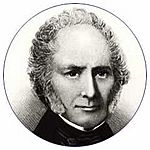William Sturgeon facts for kids
Quick facts for kids
William Sturgeon
|
|
|---|---|

William Sturgeon
|
|
| Born | 22 May 1783 Whittington, Lancashire
|
| Died | 4 December 1850 (aged 67) Prestwich, Lancashire
|
| Nationality | English |
| Known for | Electromagnet and electric motor |
| Scientific career | |
| Fields | Physics |
| Institutions | Electromagnets |
| Influences | Charles Grafton Page |
| Influenced | Charles Grafton Page |
William Sturgeon (born May 22, 1783 – died December 4, 1850) was an English physicist and inventor. He is famous for creating the first electromagnets. He also invented the first useful electric motor.
Contents
William Sturgeon's Early Life
William Sturgeon was born on May 22, 1783. His birthplace was Whittington, a small town near Carnforth in Lancashire, England. When he was young, he started working as a shoemaker's apprentice.
Sturgeon's Amazing Inventions
Sturgeon joined the army in 1802. While serving, he taught himself about mathematics and physics. These subjects would become very important in his later life.
Creating the Electromagnet
In 1824, Sturgeon became a science teacher. He worked at the East India Company's Military Seminary in Addiscombe, Surrey. The next year, he showed off his amazing new invention: the first electromagnet.
He made a piece of iron wrapped with bare copper wire. When he sent electricity from a battery through the wire, the iron became a magnet. He showed its power by lifting a nine-pound weight with this seven-ounce magnet!
Inventing the Electric Motor
In 1832, Sturgeon moved to London. He joined the Adelaide Gallery of Practical Science as a lecturer. Here, he showed off another big invention. It was the first DC electric motor that used a special part called a commutator. This made the motor practical to use.
Starting a Science Journal
Sturgeon was very dedicated to sharing scientific knowledge. In 1836, he started his own science magazine. It was called Annals of Electricity, Magnetism and Chemistry. In the same year, he also invented a galvanometer, which is a device used to detect electric current.
Working with Other Scientists
Sturgeon worked closely with other important scientists. These included John Peter Gassiot and Charles Vincent Walker. Together, they helped create the London Electrical Society in 1837. This society was a place for scientists to share ideas about electricity.
In 1840, Sturgeon became the manager of the Royal Victoria Gallery of Practical Science in Manchester. He became friends with John Davies and his student, James Prescott Joule. Joule later became a very famous physicist.
Sturgeon's Final Years
The Royal Victoria Gallery closed in 1842. After that, Sturgeon made a living by giving lectures and demonstrations. He continued to share his knowledge with others.
In 1843, he started another monthly science magazine. It was called The Annals of Philosophical Discovery and Monthly Reporter of the Progress of Practical Science. However, this magazine did not last long. It stopped publishing at the end of 1843.
William Sturgeon's Death
William Sturgeon passed away on December 4, 1850. He died in Prestwich, Lancashire. He was buried in the churchyard of St Mary the Virgin. His grave says he was "William Sturgeon – The Electrician."
See also
 In Spanish: William Sturgeon para niños
In Spanish: William Sturgeon para niños


